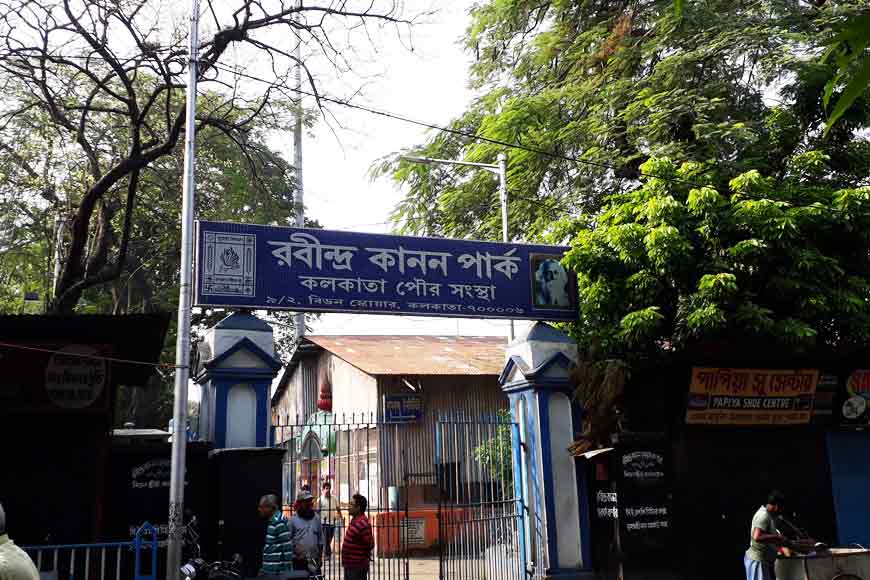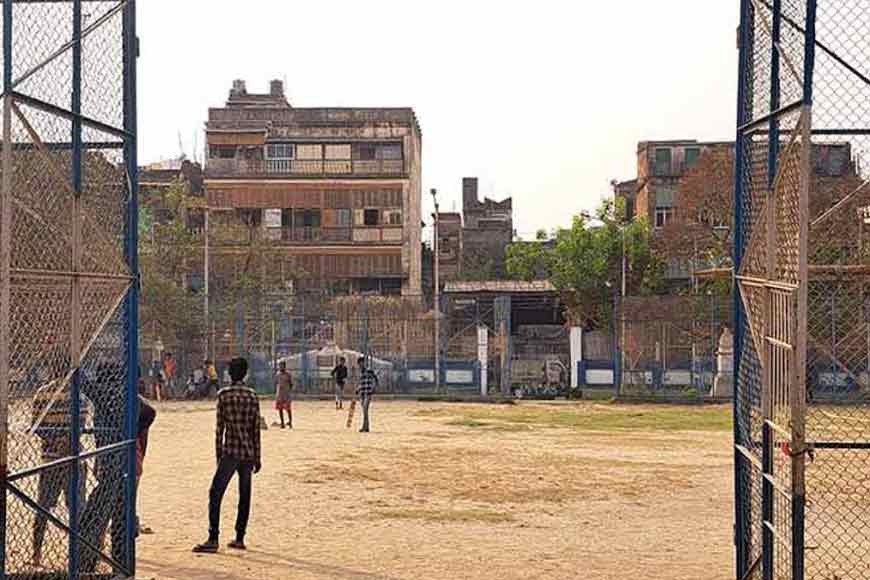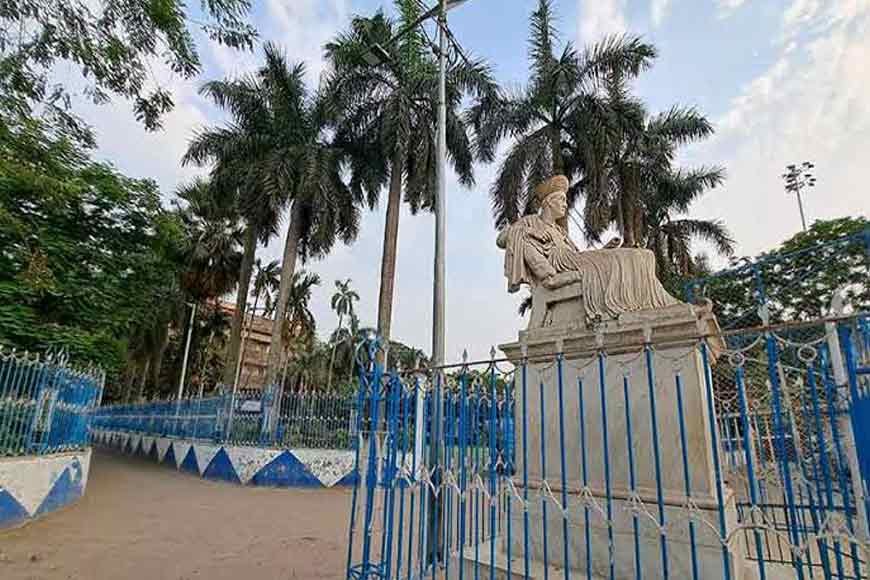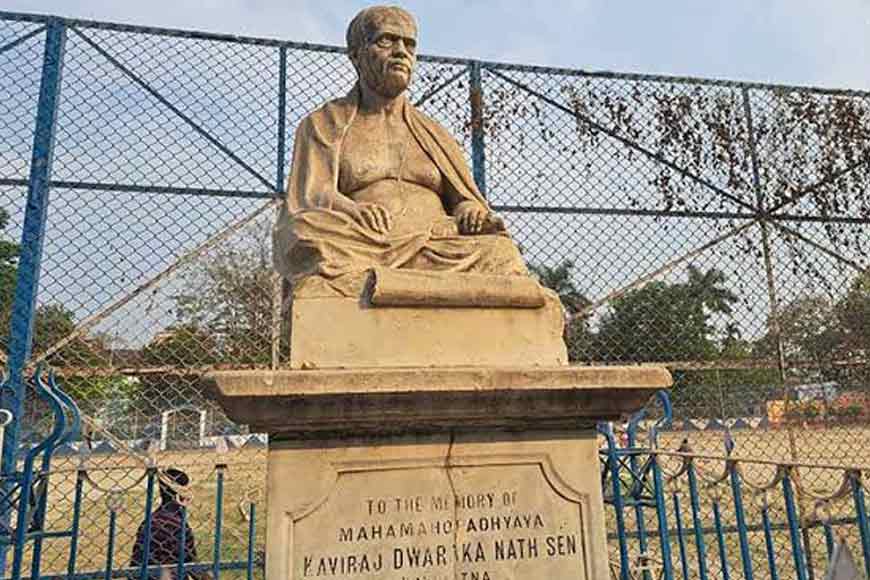Taking you through the Beadon Square – a tapestry of historical events

Every afternoon, cheers of children fill the air at Beadon Square as they engage in a soccer match. Locals are seen taking a walk maneuvering the wares left by hawkers who have precariously encroached on this wonderful park steeped in history. Many are not even aware that this Heritage Park, the one that got tagged for its historical significance, could have been one of the best-landscaped parks of India with organized walks. The British envisioned it on the lines of Hyde Park. Unfortunately, other than the mute statues of stalwarts, the park remains more as a historical specimen, rather than a vibrant piece of conservation.
Two important reports published by The Statesman, dated May 2, 1886, and another dated February 19, 1887, shows a decorated gas lamp post with an ornamental fountain in the park. These were gifted by none other than Kaliprasanna Sinha. It was later removed to Beadon Square to make space for the statue of Lord Ashley Eden. The Statesman in its 1880s reports also gives details of the illuminated decoration of Beadon Square on the occasion of Queen Victoria’s Golden Jubilee celebration. The report says: “At Beadon Square, a 30-foot-tall Hindu temple was erected and decorated with a thousand candles.”
This park has witnessed India’s freedom struggle and played an important role. Planned and developed by Calcutta Municipal Corporation between 1867-1870, the park was named after Governor General of Bengal, Sir Cecil Beadon. It was a time when the British were building the city of Calcutta and the East India Company town planners, were decorating Calcutta with many large public gardens and parks just like they had back in England where the British men and women could take a walk in the mornings and evenings and socialize or just laze. They wanted to bring in ‘green breaks to the tired eyes’ with Calcutta turning into the British India capital. Its growing population and fast urbanization needed such topographic halts. Other than Beadon Square, they came up with another huge public park named Cornwallis Square nearby.

Situated near Nimtala Ghat and off Beadon Street in North Calcutta, the park soon turned into one of the most coveted public places for residents. Thanks to its proximity to the Ganga and with many theatre halls nearby, like Star, Minerva, National Theatre, Bengal Theatre, etc. this park became popular among those who went out for evening entertainment. Many important historical events happened in this park, like in 1896 Indian National Congress had its 12th annual session in this park where delegates came from all across India. This session was important and held between December 28-31, where noted lawyer and former president of Bombay Municipal Corporation, Rahimtulla Mahomed Sayani, delivered one of the finest presidential speeches of that time from Beadon Square.
But probably the most important event in history was scripted at Beadon Square when Rabindranath Tagore took to the stage and sang Bankim Chandra Chattopadhyay’s Vande Mataram in an open public forum at this park. It was not the tune in which Vande Mataram is sung these days. As per many records, it is said Tagore sang in his own tune and style. Incidentally much later in 1905, a recording of Vande Mataram by Tagore was discovered based on Raga Desh Malhar. If you enter Beadon Square and take a tour through this park, nowhere will you get to see a plaque or any other reminders of this historic event! Tagore singing Bankim’s Vande Mataram is indeed a precious moment to be cherished and passed on to the younger generation. Most of us are unaware though.
During the Indian independence movement and political upheaval, Beadon Square became a hotspot of political meetings and demonstrations. On October 16, 1905, one of the biggest political gatherings to protest against the Partition of Bengal was organized at this park. As per newspaper archives, a huge crowd gathered here after taking a bath in the Holy Ganga and taking a pledge to upturn the order of Partition given by the British. The protest march started from this park before everyone hit the streets of Calcutta singing patriotic songs written and composed by Rabindranath Tagore. A rakhi tying ceremony as a mark of brotherhood and secular feelings was also done as the rally went from Beadon Street to Baghbazar. Even this historical event has no mention inside the square.
Not just events that have etched golden moments in the history of independence, Beadon Square hit international headlines in October 1907 when it was witness to a riot that started from this park. As per historian Suranjan Das: “On October 2, 1907, at 6 pm, a mass meeting was held here under the presidency of one Bipin Bihari Dasgupta. It was a protest meeting against the British police, who had imprisoned five young boys participating in the Swadeshi Movement. At the meeting, the local mob got provoked and that led to a huge attack on police forces for the next two days. It continued till October 4, and all of North and Central Calcutta was impacted.”

As per an article first published in the ‘Bengalee’ newspaper on June 15, 1909, Shri Aurobindo Ghosh gave a historic speech at Beadon Square. Despite the foul weather a large number of people assembled on Sunday afternoon at Beadon Square where a big Swadeshi meeting was held under the presidency of Babu Ramananda Chatterji, the editor of the Prabasi. Several speakers addressed the meeting, one of them was Aurobindo Ghose. He said that when in jail he had been told that the country was demoralised by the repression, he could not believe it then, because his experience of the movement had been very different. He had always found that when Swadeshi was flagging or the Boycott beginning to relax, it only needed an act of repression on the part of the authorities to give it redoubled vigour. It seemed to him then impossible that the deportations would have a different effect. When nine of the most active and devoted workers for the country had been suddenly hurried away from their homes without any fault on their part, without the Government being able to formulate a single definite charge against them, surely the Boycott instead of decreasing would grow tenfold more intense. And what after all was the repression? Some people were sent to prison, some deported, several houses searched, and a few repressive enactments, limiting the liberty of the press and the platform. This was nothing compared with the price other nations had paid for their liberty. They also would have to suffer much more than this before they could make any appreciable advance towards their goal. This was God's law; it was not the rulers who demanded the price, it was God who demanded it. It was his law that a fallen nation should not be allowed to rise without infinite suffering and mighty effort. That was the price it had to pay for its previous lapses from national duty.
The speaker did not think that there was any real demoralisation. There might be a hesitation among the richer and more vulnerable parts of the community to hold conferences or meetings or give public expression of their views and feelings. He did not measure the strength of the movement by the number of meetings or of people present at the meetings. He measured it by the strength and indomitable obstinacy of feeling and purpose in the hearts of the people. Their first duty was to keep a firm hold on their ideal and perform steadfastly the vows they had made before God and the nation. The rulers were never tired of saying that we should get self-government when we were fit. Fitness meant national capacity and strength was the basis of capacity. That was what Lord Morley really meant when he asked himself repeatedly whether this was a real uprising of the nation or a passing excitement. He meant, was it a movement with real strength in it, a movement with elemental force enough in it to resist and survive? That experiment was now being made. They must not expect substantial gains at so small a cost.
Today, the place is a playground of several statues that seem to have frozen in time just like the square itself. But their excellent European-styled marble sculptures still create awe for structural conservationists. As conservationist Rob Chatterjee says: “Beadon Square has several heritage statues like that of Raja Kali Krishna Deb Bahadur, grandson of Nabakrishna Deb of Sovabazar Rajbari. A well-known scholar of his time, he got the title of Raja Bahadur from the East India Company. Kali Krishna was a leading advocate of women's rights in Bengal and became the vice president of the British Indian Association. This marble statue of his that one finds in the park was actually brought from London and made by George Symonds in 1882. It has a tremendous Western influence in its sculpture and gets up and is a very good example of European stone sculpture.”

Other than this, there are statues of other stalwarts like Sita Nath Roy Bahadur, an iconic figure in Bengal’s industry and commerce. He was a founder member of the Bengal National Chamber of Commerce. He was also the commissioner of Calcutta Corporation, commissioner of Calcutta Port, member of Calcutta Improvement Trust, and Sheriff of Calcutta. This statue was sculpted by Maharashtrian sculptor Vinayak Pandurang Karmarkar. Next to it stands a marble statue of Mahamahopadhyaya Kaviraj Dwarka Nath Sen Kaviratna. Born in 1843, Dwarakanath Sen was one of the greatest exponents of indigenous medicine in India. He was the first to form the Ayurvedic School of Bengal and won the title Mahamahopadhyaya. Then is the statue of poet Priyanath Sen, who was very close to Tagore. He was a lawyer, book critic, writer, and an astrologer. Other than these statues, there is a unique memorial dedicated to Kali Charan Banerjee.
The gas lamps are no more. As the darkness of night descends in this historic square, one wonders where did all the days of glory go!











